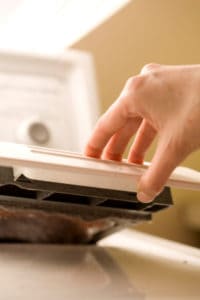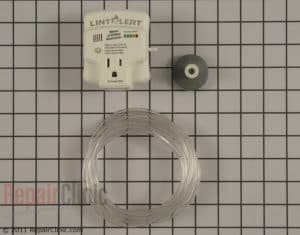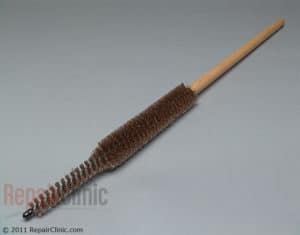The four things that can hurt your dryer include not cleaning the lint filter regularly, overloading the dryer, having an unlevel dryer, and allowing lint to build up in the venting tube. You should clean the lint filter after every load and occasionally clean the lint from the chute with a long-handle brush or long vacuum hose attachment.
Overloading can damage the drum and bearings, while an unlevel dryer might wear out parts prematurely, so use a level to adjust its feet properly. Lastly, clean the venting system annually with a 20-foot cleaning brush to prevent major fire risks, and consider using a Lint Alert to monitor for blockages.
1. Not cleaning the lint filter
People often ask, “Are fabric softener sheets bad for my dryer?”
No, fabric softener sheets are not “bad” for your dryer. However, chemicals from the sheets may leave residue on the lint filter (a.k.a. lint screen). If the lint filter is not cleaned off from time to time, it may become partially clogged and restrict proper air flow. The residue could also coat the electronic moisture sensor, which has the important job of sensing moisture in clothing. If this sensor is damaged, it will send inaccurate messages about the presence of moisture and disrupt drying time, leading to big problems. Tweet this tip.
You can clean the filter using a little bit of detergent and a soft-bristle brush. You can wipe off the sensor with a cotton ball and a small amount of rubbing alcohol.
 Counting sheets
Counting sheets
Sometimes softener sheets lodge themselves within the lint filter and the lint filter housing or over the vents on the inside of the dryer. Pay attention when you remove a load of clothes from your dryer. If the sheets are missing, find them. Tweet this tip.
How often should you remove lint from the lint filter?
You should remove lint after every load. As your dryer’s owner manual will emphasize, this step is extremely important to its proper functioning.
A few times per year, it’s also wise to clean lint from the chute that houses the lint filter. Pieces of lint inevitably settle in there as you remove and replace the filter. This long-handle brush works well for this. You can also use this long vacuum hose attachment to do the job fast, too.
2. Overloading it.
Read your dryer’s owner manual for specific information about load sizes. Overloading your dryer can cause damage to the drum, bearings and other important components. Additionally, an overloaded dryer will not properly dry clothes. You’ll find that the clothing may be overly dried in some spots and damp in other areas. Tweet this tip.
3. Keeping it level
All appliances in your home should be level in order to work effectively. Having an unlevel dryer may lead to premature wearing of critical parts. Place a bubble level on the dryer to check this.
Follow your dryer’s owner manual for instructions on how to properly and safely adjust the dryer’s feet to attain the most level position possible. Most laundry room floors are, unfortunately, rarely level themselves.
4. Leaving lint buildup in venting tube
Lint, dryer venting system blockage and heat are a lethal combination. Every year, clothes dryers cause thousands of major residential fires in the U.S.
So, we’re not exaggerating when we tell people that it’s a serious necessity. A venting system should be cleaned out from inside of the dryer to the outside vent cap at least once per year. Our bestselling 20-foot cleaning brush enables you to easily remove lint buildup from within the entire tube. If you have a gas dryer, consider Lint Alert. It monitors for lint build-up and other blockage and alerts you if there is a fire risk with your gas dryer. Does it work? Consumer Reports says yes.

Pieces of lint inevitably settle in there as you remove and replace the lint filter. This long-handle brush works well for this. It’s extremely common for lint to build up within the dryer, too. You should disassemble the dryer and remove the lint from the dryer’s interior using a vacuum. You can also use this long vacuum hose attachment. Tweet this tip.

Related helpful information
7 dryer care facts to keep your home safe and save you money
How to prevent pilling on your clothing
9 tips for washing machine care
Maintenance tips
Learn something from this post? Share it! Tweet this.
Something broken? We’ll help.
RepairClinic.com’s free online repair help system will help you find the most likely causes of dryer problems as well as the correct, recommended replacement parts. There you’ll also find how-to repair help information with 1,000+ expertly-produced videos.
RepairClinic.com has replacement parts for dryer, washing machines, refrigerators, ice machines, ranges, stove tops, ovens, dishwashers, lawn mowers, chainsaws, furnaces and more.
About RepairClinic.com
Since its founding in 1999, RepairClinic.com® has helped three million do-it-yourselfers save 225 million dollars in repair costs by successfully repairing appliances and outdoor power equipment on their own.
RepairClinic’s free online repair help system empowers do-it-yourselfers to fix common problems associated with major home appliances, outdoor power equipment, HVAC equipment, water heaters, floor care, and more. DIYers can enter a model number to choose from a list of common symptoms for that particular model to then troubleshoot and watch expertly-produced videos to learn the most likely causes and conditions and purchase the correct, recommended part.
RepairClinic.com stocks more than one million parts and accessories for 160 brands of furnaces, air conditioners, air handlers, heat pumps, washing machines, dryers, dishwashers, vacuum cleaners, lawn mowers, snowblowers, leaf blowers, edgers and many other products.
Since 1999, the company has served more than three million customers including homeowners, first-time and beginner DIYers, advanced DIYers, appliance repair professionals, small engine repair shops and landscaping and lawn care business owners. RepairClinic orders are backed by a 365 Days. Period.® return policy that enables customers to return any part. Of the more than one million parts available on the website, 95 percent of parts ordered are in stock and guaranteed to ship the same business day. RepairClinic ships within the United States and Canada.
Comments are closed.